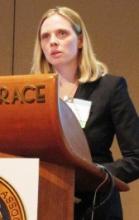MADISON, WIS. – Patients with normal calcium levels and elevated parathyroid hormone levels after curative parathyroidectomy do not have higher rates of recurrent primary hyperparathyroidism than those with normal parathyroid levels, according to a single-center review of 310 patients.
No patient developed recurrent disease after a mean follow-up of 26 months, Dr. Carrie Carsello said at the annual meeting of the Central Surgical Association.
"Given our lack of recurrence, routine measurement of PTH levels postoperatively may not be necessary in normocalcemic patients," she said. "Persistently elevated PTH levels in patients with normocalcemia likely do not matter."
This controversial conclusion sparked a lively debate, with some attendees calling for longer follow-up and others expressing concern at abandoning repeat parathyroid hormone (PTH) measurements.
Invited discussant Dr. Rebecca Sippel, chief of endocrine surgery at the University of Wisconsin, Madison, observed that elevated PTH levels after curative parathyroidectomy are a common and poorly understood problem that causes a great deal of testing and angst for patients and physicians alike. She questioned whether longer follow-up would change the authors’ conclusion, citing a recent paper that reported multiple postoperative PTH fluctuations over 10 years’ follow-up and recurrence rates of 1.1% in patients with normal postoperative PTH and calcium levels and 5% in those with normocalcemic parathormone elevation (Surgery 2011;150:1076-84).
Dr. Carsello said that many reports have shown that PTH elevations are a transient phenomenon and that some of their own patients initially had an elevated PTH that normalized, while others developed elevated PTH over time. The only thing that jumped out when they compared patients who initially had a calcium level higher than the 9.7-ng/mL cutoff, was that they had smaller glands resected. She also noted that calcium follow-up in some patients reached almost 10 years, "so it’s kind of hard to say that with longer follow-up we would have seen an increase in recurrence."
In the current cohort, surgery was curative in 300 patients. Ten patients had hypercalcemia at 6 months, six with persistent primary hyperparathyroidism and four with recurrent primary hyperparathyroidism.
Among the remaining 300 patients, 62 (21%) had elevated PTH levels and 238 had normal PTH levels at 6 months, said Dr. Carsello, an endocrine surgery fellow at the Medical College of Wisconsin in Milwaukee. All had normal calcium levels, and 85% had single-gland disease at the time of surgery. Their mean age was 60 years.
Data available at 1 year for 155 of the 238 patients revealed elevated calcium levels in 3 patients and normal calcium in 152. Continued follow-up beyond 1 year in 118 of these patients showed that 106 remained normocalcemic with normal PTH levels and 12 had normal calcium, but developed elevated PTH (10%).
Among the 62 patients with elevated PTH at 6 months, all 38 with data available at 1 year had normal calcium, she said. Additional follow-up available in 32 of the 38 patients revealed that 15 remained normocalcemic with normal PTH levels, while 17 were normocalcemic with elevated PTH (53%).
Postoperative calcium levels measured at 3 months, 6 months, and at least 1 year were significantly different between the 238 patients with normal PTH levels and the 62 patients with elevated PTH only at 6 months (9.6 mg/dL vs. 9.7 mg/dL; P = .0009), Dr. Carsello said.
As expected, PTH levels were significantly higher in the elevated PTH group at 3 months (89 pg/mL vs. 44 pg/mL), 6 months (89 pg/mL vs. 39 pg/mL) and at least 1 year (78 pg/mL vs. 39 pg/mL) (P less than .001 for all three). In addition, patients with elevated PTH had significantly lower 25-OH vitamin D levels at 6 months (30 ng/mL vs. 36 ng/mL; P = .05).
"Given the small numbers, it is difficult to say whether elevated PTH levels were secondary to vitamin D deficiency alone or if other factors played a role," Dr. Carsello said.
Still, the finding of lower 25-OH vitamin D levels supports aggressive vitamin D supplementation in patients following parathyroidectomy.
"We routinely recommend vitamin D supplementation in patients with levels less than 32 [ng/mL]," she said.
Attendee Dr. Christopher McHenry, director of general surgery at MetroHealth Medical Center in Cleveland, said the main message he took from the analysis is that measuring PTH levels after surgery is not necessary, because "the issue here is that you’re not going to intervene unless the patient is hypercalcemic and so probably the most reasonable way to follow these patients is with serum calcium levels."



